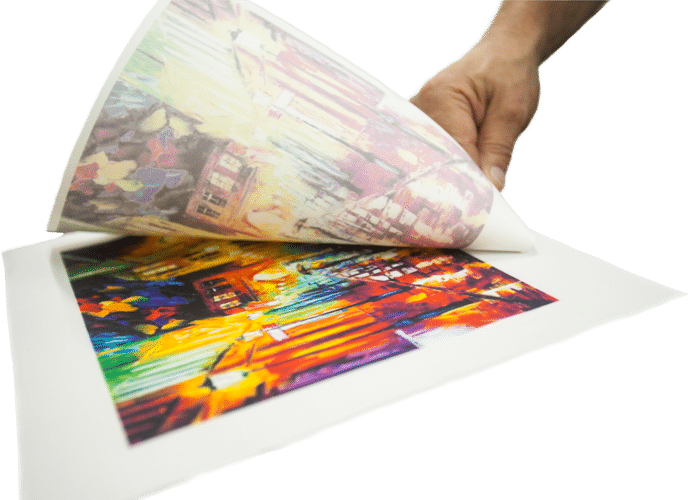What is dye sublimation anyway?
 Good question. Look around you. Most of what you see has used the dye sublimation process if it’s printed. Coffee mugs, hats, socks, sport shirts, flags, even furniture and other textiles.
Good question. Look around you. Most of what you see has used the dye sublimation process if it’s printed. Coffee mugs, hats, socks, sport shirts, flags, even furniture and other textiles.
Dye sublimation requires a printed image to be transferred to the object using heat. An image may be printed on transfer paper that is held against , say a coffee mug by a heat press at high temperature for a little less than a minute. The ink on the transfer paper is transformed into a gas that then combines with the object and is very permanent in nature when finished. The object of course must be able to accept the gaseous ink. For textiles, that means it must be a polyester. Since the temperatures for the transfer can reach 300-400 degrees F, the object must also have the property of not “burning” or discoloring at that high temperature.
 There is an alternate method for dye sublimation printing where the ink is applied directly to a substrate that has been coated. Ink bonding is achieved by exposing the fabric to heat. This is typically used when the substrate is very wide and perhaps long, such as with sheets or bed cover, curtains etc.
There is an alternate method for dye sublimation printing where the ink is applied directly to a substrate that has been coated. Ink bonding is achieved by exposing the fabric to heat. This is typically used when the substrate is very wide and perhaps long, such as with sheets or bed cover, curtains etc.
What Do You Need to Start a Dye Sublimation Business?
1. First and Foremost, Imagination.
The dye sublimation process allows you to print to a variety of objects. That being the case, start looking around you and making a list of things you might want to sell.
2. A Sublimation Printer
Now here is where you need to do some research. Don’t get pulled into something that won’t allow you to grow. Some printers may be inexpensive, but once you become a bit known, you are going to be asked to do more, wider, longer.
If you get a sublimation printer that can only use 8×10 or 11×17 sheets of transfer paper, you are limited to those sizes. Consider spending a bit more and getting a printer that might allow you to go 24 inches and longer lengths or if you really want to jump in, even wider printers such as a 54 inch wide format printer.
 Hey, here at MUTOH we want you to get the right start, so consider talking it over with one of our experts who can give you some good advise. Yep, we’ll even tell you if the smaller 8×10 printer is the right choice for you. Later, we know you’ll thank us by getting one of our wide format printers if you grow.
Hey, here at MUTOH we want you to get the right start, so consider talking it over with one of our experts who can give you some good advise. Yep, we’ll even tell you if the smaller 8×10 printer is the right choice for you. Later, we know you’ll thank us by getting one of our wide format printers if you grow.
As an example, the typical smaller budget printer, like the Epson model shown above accepts A3 (11.69 x 16.54 in)/A4 (8.27 x 11.69 in) transfer paper. Good for a lot of stuff, but limiting regarding length and width for that matter.
A better choice might be the MUTOH ValueJet RJ900X if you have a tighter budget or a 1624WX that will give you real printing power. These are real business printers not just hobby printers. As I mentioned earlier, once you get a bit known, you are going to be happy you didn’t have to turn down work just because your printer wasn’t wide enough or versatile enough to accommodate the job or the number of items you needed to make.
real printing power. These are real business printers not just hobby printers. As I mentioned earlier, once you get a bit known, you are going to be happy you didn’t have to turn down work just because your printer wasn’t wide enough or versatile enough to accommodate the job or the number of items you needed to make.




 So, you’ve either bought a MUTOH dye sublimation printer or are looking at one. If you are now looking at transfer paper for a MUTOH printer there are some things you may want to consider.
So, you’ve either bought a MUTOH dye sublimation printer or are looking at one. If you are now looking at transfer paper for a MUTOH printer there are some things you may want to consider.














 The value of this software is that it has the design and output features to make your workflow much more fluid and profitable. Little things like nesting of images to save media, control over ink density for better color transfers and more, make it a worthwhile consideration when purchasing your printer. It also has the features to handle your growth even if that growth is into other markets!+
The value of this software is that it has the design and output features to make your workflow much more fluid and profitable. Little things like nesting of images to save media, control over ink density for better color transfers and more, make it a worthwhile consideration when purchasing your printer. It also has the features to handle your growth even if that growth is into other markets!+ choices here and much of that choice will have to do with what printer you choose and what kind of applications you wish to make. Some heat presses are made for a specific kind of project like shirts, or hats and others may come with accessories that allow you to do many different kinds of items. Again, do your research.
choices here and much of that choice will have to do with what printer you choose and what kind of applications you wish to make. Some heat presses are made for a specific kind of project like shirts, or hats and others may come with accessories that allow you to do many different kinds of items. Again, do your research.
 The light box was a TREMENDOUS hit, and even if the pics from my phone don’t do it justice, I saw so many other people taking pictures of it, that I lost count.
The light box was a TREMENDOUS hit, and even if the pics from my phone don’t do it justice, I saw so many other people taking pictures of it, that I lost count.





 Posted by
Posted by 






 Textile Printing & More
Textile Printing & More